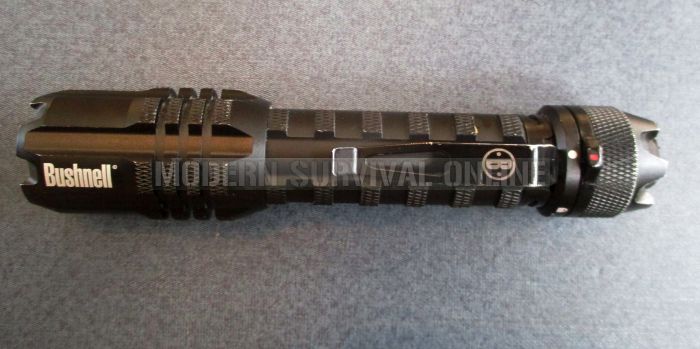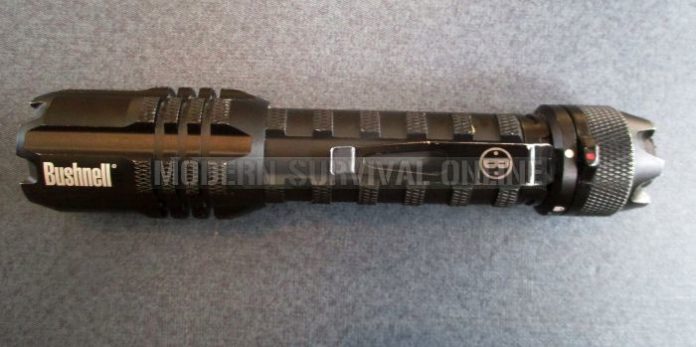If there is one tool that everyone should carry when they leave the house, it should be a flashlight, and preferably a bright, tough and compact tactical flashlight. These modern lights are incredibly robust and have outputs typically measured in the multi-hundred lumen range, making them more than adequate for basic illumination and also for dazzling an attacker by removing their visual horizon.
One common feature that is puzzling to the uninitiated is the sharp “crown of spikes or edges surrounding the bezel and sometimes the tailcap.

Why does a flashlight have these sharp protrusions? These sharpened projections, or crenellations, afford the flashlight better efficacy as a striking tool by focusing the power of a blow into a smaller area, and also serve as a tearing weapon when used with pressure techniques or joint locks. They also serve as a standoff for the lens, helping to protect it from direct impact.
There is more to know about flashlight crenellations, and like all options they come with tradeoffs. The trick is knowing if the benefits outweigh the setbacks before investing in a light that has them or adding them to an existing light. We’ll tell you what you need to know in the rest of this article.
Flashlight Anatomy
To be clear, not every sharp or aggressive surface on a flashlight is considered crenellations. Plenty of flashlights these days, including ones with crenellations, have other features that are decidedly for other purposes.
Two of the most popular are grip texturing in the form of checking, or knurling, and glass breaker points. You might even see a flashlight body with some fairly radical fins or discs machined into it; these are for radiating waste heat and not any special tactical task.
Though modern lights often have highly aggressive grip texturing to ensure the user retains their purchase on the light even in the most extreme conditions, these are for the user of the light, and not for applying to the forehead, neck or collarbone of the attacker.
Glass breaker points may appear similar to crenellations at first glance, being spiky protrusions on the bezel or tailcap, but are intended for busting, yup, glass, and not people. It should be noted that glass breakers can add a little more pop to blows against bone, however.
Crenellations though, are specifically the ring of protruding chisel-shaped prongs that emanate from the rim of the bezel, the tailcap or both. They are easy to identify once you know what to look for. Keep reading to learn a bit more about these useful tools.
Crenellations in Action
Crenellations exist solely to allow the user of the flashlight more options and greater effectiveness when striking with the flashlight, or using it to apply holds and locks in hand-to-hand combat.
Affording the lens additional protection is a tertiary benefit at best. It is true that popping someone with a hardened cylinder of aluminum, steel or brass in the form of a modern flashlight is going to hurt bad enough, but crenellations ensure it will hurt even worse!
The thin points that form the impact point of a blow delivered with a crenellation-equipped flashlight translate into considerably higher impact and correspondingly more pain on impact. They also have a nasty tendency to “nibble” their target, drawing blood.
This has led to the sometimes derogatory moniker of “DNA collectors” since the crenellations tend to scoop up some of the target’s blood and tissue under their “teeth”. But strikes, however effective, are not the only way to employ crenellations.
Another high-ROI technique is a rake, achieved in exactly the way you are likely imagining. By striking and holding or pressing the “teeth” into the target and then violently pulling laterally crenellations can inflict not-insignificant soft tissue damage and cause considerable pain without inflicting a lethal wound.
This is especially agonizing when delivered to any part of the body where bone is unprotected by layers of muscle and fat.
For users skilled in various martial arts or the use of a kubaton or yawara stick a crenellations-equipped flashlight is even better still.
Small joint locks, soft-tissue blows and pressure point holds are even more effective utilizing such a flashlight for the purpose, and also provide better control by increasing grip on the bad guy. You certainly have a lot of options with one of these flashlights!
Discreet and Low-Profile
Sure, they aren’t much of a weapon in the grand scheme of things, but a tactical flashlight that sports crenellation can still dole out some harm, and will definitely work better than your balled fist alone.
It is a good thing then that you can expect your flashlight to go with you quite literally anywhere. That is because a flashlight is not a weapon, and so long as your crenellations don’t look like some Crown of Doom on a heavy metal album cover they won’t even warrant a second look from any security personnel in the vast majority of weapons-restricted areas.
I have never encountered any such checkpoint or inspection anywhere, even on a commercial airline flight, where the crenellations were deemed suspicious. I have never had a light confiscated, turned away or passed to “higher” for a judgment call and I have travelled all over!
If you are working or travelling in an ultra-low profile capacity, or are in a setting or engagement with a strict no-weapons policy such a flashlight might be the only tool you can comfortably carry without any fear of being detected and facing severe legal or social consequences.
“It’s better than nothing!” is not what you want to hear when you need a weapon, but the old saw speaks for itself!
The Tradeoffs of Crenellations
Like I said in the beginning of the article, there is no perfect tool or perfect solution to anything in this world; it is all tradeoffs, and so it is with crenellations, though the tradeoffs are, in my opinion, mercifully few compared to the advantages.
Any given flashlight with crenellations will be a little harder on your clothing, holsters and pouches than it would be without them otherwise. They are infamous for tearing up hems and stitching on pockets, belts, pouches and anywhere else you stash them.
This will necessitate more frequent repair or replacement of clothing and can even leave a telltale mark that other, violent-of-mind people can recognize for what it is: track marks that indicate the frequent carriage of “tools”.
These sharp bits also tear up skin- your own! Carrying a “crowned” light bezel up in a pocket (in an effort to avoid clothing damage, of course) means a speedy attempt at a draw could see those same protrusions tearing up your hand and storing your DNA.
The sublime feeling of jamming one in between your fingers or, worse, under a fingernail at draw-it-right-damn-now speed is uniquely agonizing. I promise you won’t like (or forget!) the experience.
Some critics condemn crenellations for making carry and handling of the flashlight harder and more painful in return only for a fractional increase in tertiary mission effectiveness, and that might be a fair criticism.
A flashlight needs to be a flashlight first and foremost, after all. Nonetheless, the increase in striking potential and additional options it grants trained martial artists must not be discounted, especially if one needs a low-profile option that will pass inspection in sensitive areas and events.
Conclusion
The sharp protrusions, or crenellations, on the bezel or tailcap of a flashlight are intended to be striking tools that will enhance the efficacy of blows in delivered with the flashlight in close combat by focusing the force on a small surface area or by raking and tearing the skin of the attacker. They also improve effectiveness when used with joint locks and pressure point techniques.
As a low-profile, go-anywhere option they definitely are a “value added” option for a flashlight carried with a purpose though their tendency to rough up clothing and the user’s hands must not be discounted.
via modern survival online


